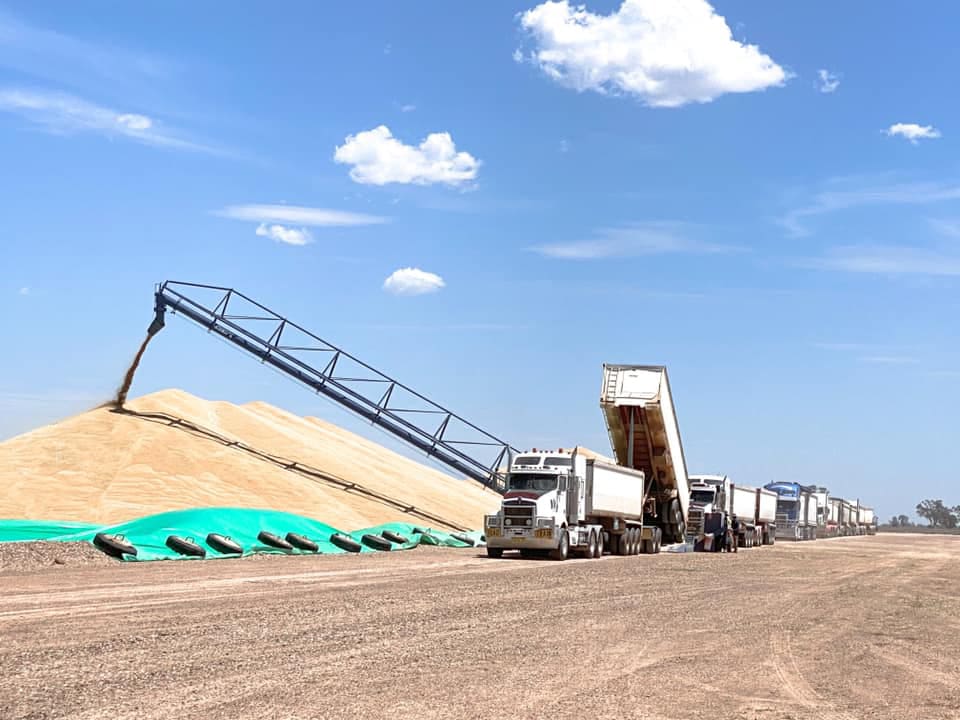
Grain is delivered to Robinson Grain’s Trangie site last week. Photo: Robinson Grain
WHEAT and barley has traded mostly steady to higher this week to reflect some short covering in the market amid limited availability of trucks to haul grain to consumers.
Trucks are tied up with on-farm or local grain haulage in the harvest epicentre, which has now moved into the southern half of New South Wales and the Victorian Mallee as activity winds down in north-west NSW.
Rain in Victoria in the past week slowed harvest for a day or two and, with temperatures forecast to exceed 40 degrees Celsius in most grain-growing regions of south-eastern Australia, heat-related harvest bans could pause progress for a few days as harvesters minimise fire risk.
Meanwhile, exporters are busy accumulating and loading vessels, with rail the preferred method to get wheat, barley and canola to port.
With selling from growers thin as they concentrate on harvesting, sell-side pressure remains minimal, and domestic feedgrain users are reluctant to compete with exporters at current levels.
In central and northern NSW, bulk-handler and trader storages are nearing full capacity.
Some are full and have temporarily shut the gate as they wait to push some stocks into the export supply chain before reopening to receivals.
| This week | Last week | Change | |
| Barley Downs Dec | $270 | $270 | Steady |
| Barley Downs Jan | $270 | $270 | Steady |
| Barley Melbourne Dec | $246 | $250 | Down |
| Barley Melbourne Jan | $242 | $240 | Up |
| Wheat Downs Dec | $300 | $302 | Down |
| Wheat Downs Jan | $308 | $300 | Up |
| Wheat Melbourne Dec | $312 | $310 | Up |
| Wheat Melbourne Jan | $305 | $304 | Up |
| Sorghum Downs Mar-Apr | $325 | $312 | Up |
Table 1: Indicative delivered grain prices in AUD per tonne.
Heat troubles sorghum
Most dryland sorghum crops in southern Queensland are suffering because of continuing dry conditions, and no respite is in sight with an extremely hot weather forecast.
Some feedlots have been fielding inquiry from growers looking at the economics of cutting struggling sorghum crops for silage.
With a ballpark average yield for sorghum silage at 6 tonnes/hectare, and a price of around $75/t to gross $450/ha, even a yield of 2t/ha on current values makes taking the crop through to grain harvest a better option.
Bulk handlers operating in southern Queensland and throughout NSW are mostly focussed on accumulating for export, and are therefore not offering parcels of wheat or barley into the domestic market.
“Growers in the north aren’t selling much,” one trader said, adding that the impact of this hot and dry end to spring was limiting yield potential for the southern Queensland sorghum crop.
“There’s barley everywhere and they’re not selling it.”
Feedlots are generally thought to have covered at least half their requirements from January to June, and have few positions left to cover through December to February.
“Wheat would work at $295/t but it’s above that now.
“It looks like we’ll be on barley for the next 12 months.”
Barley has remained the preferred grain for feedlots, but getting it north on to the Darling Downs from northern NSW has been difficult.
“There are no trucks from NSW to bring up any of that cheaper grain,” Alliance Grains principal Luke Walker said.
“Trucks don’t want to go more 50 kilometres; they’re making good money staying close to farms.
“A bit of rain will change things.”
If cartage for trucks stops because of rain or a harvest ban, some operators who have followed the harvest south are likely to head home to southern Queensland and bring a load of barley with them.
This will pressure northern barley values, particularly if rain falls on the Downs to bolster yield prospects for the sorghum crop now in the ground.
Quality deliveries prevail
Container packers and export accumulators are seeing high-protein and good-quality grain being delivered against contracts and sold for cash.
While some frost-damaged wheat and barley has been harvested in NSW, growers report affected area is minimal, and is mostly being stored on farm.
In central NSW, domestic flour millers on wheat classified Australian Prime Hard (APH), plenty of which it is making 14-15pc protein, remain active buyers of those classifications and also of H1.
GrainCorp last night closed its Trangie storage to deliveries but its, and other operators’, sites in the Macquarie Valley remain open as they near capacity and the plains harvest moves into its dying days.
In Victoria, Wilken Group trader Andrew Kelso said high quality had been the hallmark of Victorian wheat to date.
“Rain stopped people for a couple of days, and now it will get very hot anywhere north of the Great Divide,” Mr Kelso said.
“There’s a lot of APH and H1 in the Mallee, and now people are chasing ASW and APW, particularly for the container market.
“People are still paying a premium for December delivery.”
In the southern market, 60,000t of barley due to load out of Portland next month is expected to go to Saudi Arabia, and 25,000t is already on its way to the UAE from Melbourne.
Coupled with prevailing demand from feedlots, this is supporting eastern Australia’s barley values.
Grain Central: Get our free cropping news straight to your inbox – Click here



HAVE YOUR SAY